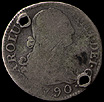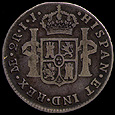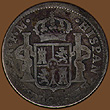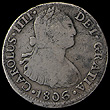Spanish Milled Coinage
TWO REALES (continued)
obverse |
|
reverse |
| |||
2R 1790 M-MF Charles IV new plate "head" pistareen (Madrid, Spain)
Obverse: CAROLU[S] IIII · DEI · G [·] / [· 1]790 .·
Reverse: · HISPANIAR[U]M · RE[X ·]
Weight: 80.4 g (5.21 grams) Diameter: 26.4 mm
Comments: This is a "new plate" coin minted in Spain. New plate refers to the 20% reduction in the value of reals minted in Spain in relation to the reales minted in colonial Spanish America. This variety of coin was frequently called a "head" pistareen in the British colonies to distinguish it from the more valuable "portrait or modified pillar" two real minted in the Americas. The more valuable American coin included the modified pillar reverse with the crowned Spanish arms while the Spanish new plate pistareen displayed only the crowned Spanish arms.
On the reverse the coin is fairly worn. To the left of the crowned Spanish arms was an R (worn off this example) while to the right is the numeral 2, for the denomination Reales 2. Below the R on the left is the mintmark of a crowned M for Madrid. On the right of the shield below the hole are the initials MF for the assayers Maniel de Lamas and Francisco Herrera who worked together 1788-1802 (see Pellicer i Bru, Glosario, pp. 33 and 154). This example has holes at 4 o'clock and 11 o'clock. According to Thomas Kays holed coins were like modern traveller's checks. A traveller would sew or pin several of these coins into the lining or inside of their jacket and use them as needed.
Provenance: Donated to Notre Dame in 1887 as part of a 2,300 item coin collection (see: The Notre Dame Scholastic, vol. 21 (September 1887) 45.
obverse |
|
reverse |
| |||
2R 1793 LIMAE-IJ Charles IV portrait coinage (Lima, Peru)
Obverse: CAROLUS · IIII · DEI · GRATIA · 1793 ·
Reverse: · HISPAN · ET IND · REX · [LIMAE monogram] · 2 R ·
I · J ·
Weight: 96.1 g (6.22 grams) Diameter: 38.3 mm
Comments: This is an example of the "portrait" or "modified pillar" design with a portrait of Charles IV on the obverse and the Spanish arms between the two pillars on the reverse. In the reverse legend the monogram 'LIMAE' is the mintmark indicating the coin was produced at the mint in Lima, Peru. This is followd by '2 R' which indicates the denomination of two reales. The I and the J are the initials of the assayers, Ignacio Zenón Gélves and Juan Martínez de Roxas who worked together from 1787-1803 (see Pellicer i Bru, Glosario, pp. 31 and 125). There is one large and several small die cracks at the 1 and the 7 in the date.
Provenance: From the Robert H. Gore, Jr. Numismatic Collection.
obverse |
|
reverse |
| |||
2R 1799 Mo-FM Charles IV portrait coinage (Mexico City)
Obverse: CAROLUS · IIII · DEI · GRATIA · 1799 ·
Reverse: · HISPAN · ET IND · REX · Mo · 2 R · F · M ·
Weight: 95.4 g (6.18 grams) Diameter: 27.1 mm
Comments: This is an example of the "portrait" or "modified pillar" design with a portrait of Charles IV on the obverse and the Spanish arms between the two pillars on the reverse. In the reverse legend Mo is the mintmark indicating the coin was produced at the mint in Mexico City. This is followd by '2 R' which indicates the denomination of two reales. The initials F and M are for the assayers,Francisco Arance y Cobos and Mariano Rodríguez who worked together from 1783-1807 (see Pellicer i Bru, Glosario, pp. 40 and 110).
Provenance: Donated to Notre Dame in 1887 as part of a 2,300 item coin collection (see: The Notre Dame Scholastic, vol. 21 (September 1887) 45.
obverse |
|
reverse |
| |||
2R 1806 LIMAE-JP Charles IV portrait coinage (Lima, Peru)
Obverse: CAROLUS · IIII · DEI · GRATIA · 1806 ·
Reverse: · HISPAN · ET IND · REX · [LIMAE monogram] · 2 R ·
J · P ·
Weight: 97.9 g (6.33 grams) Diameter: 27.0 mm
Comments: This is an example of the "portrait" or "modified pillar" design with a portrait of Charles IV on the obverse and the Spanish arms between the two pillars on the reverse. In the reverse legend the monogram 'LIMAE' is the mintmark indicating the coin was produced at the mint in Lima, Peru. This is followd by '2 R' which indicates the denomination of two reales. The J and the P are the initials of the assayers, Juan Martínez de Roxas and Pablo Cano Melgarejo who worked together from 1803-1823 (see Pellicer i Bru, Glosario, pp. 31 and 139). In the date there are breaks probably due to defective punches in the numbers 8 and 0.
Provenance: From the Robert H. Gore, Jr. Numismatic Collection.
obverse |
|
reverse |
| |||
2R 1818 Caracas-BS Ferdinand VII royalist coinage (Caracas, Venezuela)
Obverse: [Cross of Jerusalem within arms of Castile and Leon. Above
and below the cross are "· 2 ·", and to the left is an
"F" and to the right a "7" each with a stop above and a stop
below.]
Reverse: 2 / PLV SVL TR /
B . 1818 S . / CARACAS
Weight: 73.6 g (4.77 grams) Diameter: 24.0 mm
Comments: The Caracas mint opened in 1802 producing a new style of 1/8 and 1/4 Real coins until 1805. The area rebelled from Spain in 1810 but surrendered to Spanish forces in July of 1812. At that time the mint reopened producing royalist coinage as before but also producing 1, 2 and 4 reales pieces in imitation of the early cob style coinage (1817-21). This is an example of the royalist two reales. The obverse bears a cross of Jerusalem as part of the arms of Castile and Leon. The number 2 above and below indicates the denomination, two reales, while the F 7 refers to the king, Ferdinand VII. On the reverse is the pillar and waves design. The 2 indicates the denomination. The next line gives an abbreviated form of the motto Plus Ultra (more Beyond). Following this is the date with the initials B. to the left and S. to the right for the assayer BaroloméSalinas who worked at the mint from 1817 until the end of the royalist coinage in 1821 (see Pellicer i Bru, Glosario, pp. 26 and 81). Contemporary counterfeits of this coin were struck on German silver. This example has a hole at 9:00 o'clock. According to Thomas Kays holed coins were like modern traveller's checks. A traveller would sew or pin several of these coins into the lining or inside of their jacket and use them as needed.
Provenance: Donated to Notre Dame in 1887 as part of a 2,300 item coin collection (see: The Notre Dame Scholastic, vol. 21 (September 1887) 45.
| Spanish Milled Coins: p.3 | Section Contents | Spanish Milled Coins: p.5 |
|
For viewing tips and information on optimal computer settings click
here.
For questions or comments contact Special Collections by: |









